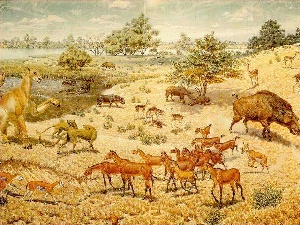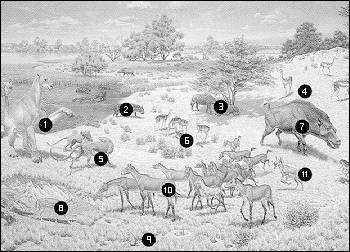The Beasts
A Blast to the Past
21 Million Years Ago I Was Taking a Walk…
Come and return to a day along the Niobrara River in western Nebraska 21 million years ago! To set the mood, think about movies or documentaries you may have seen of modern Africa during the last 40 years. Think of a land swarming with life, of extensive grasslands dotted with trees through which great herds of grass- and leaf-eating animals are wandering. Look sharply into the shadows under the trees and amid the high grass where the meateaters are resting or stalking their prey. When you have this picture of wildlife in mind you're ready for your journey into the past. Now, projecting yourself those 21 millions of years, you find yourself in a landscape filled with animals of all sorts. Some of these animals are not much different from those living today, but others are so bizarre that you may have a hard time believing they really existed.
Dawn is building a new day and those animals which hunt and feed at night are disappearing into their lairs. As the light spreads over the land we see that it is an open, sunny place of mixed grasses and trees — mostly grassland, but here and there, are single trees or small clusters of trees not big enough to be called groves. We would call this land a savanna. A broad river runs through the land, and for lack of a better name we can call it the Niobrara or "Running Water," the name given by Indians to the much smaller modern stream. This ancient Niobrara was a bold, wide stream with deep pools and sandbars. It was not cutting a valley as its modern counterpart is doing, but was carrying sand and silt down from the then-young Rocky Mountains. It sometimes flooded, and as it spread out over the wide, flat plain it deposited layers of sand and silt that geologists today call the Harrison Formation. The ancient Niobrara and other similar rivers spread the same sediments over nearby areas in eastern Wyoming and southwestern South Dakota. In the sediments, paleontologists would one day find millions of bones.
Our ancient river was the center of life for an untold numbers of animals. They lived in it, along its banks, in the willow thickets that grew on its more permanent sandbars, and on the broad, tree-dotted plains that stretched to the horizon beyond the river's normal course. Great herds of small horses, rhinoceroses, camels, and other dwellers on the savanna came to water holes to drink and to wallow in the cool and refreshing pools.
We know that in the modern world rhinos belong in Africa and southeastern Asia, not North America, yet this continent was the major home of these strange beasts for millions of years. Rhinos did not become extinct in North America until about 5 million years ago, during the middle Pliocene. Along the ancient Niobrara the rhino herds are not made up of the giant mammals we see in zoos today. The ones we see moving slowly toward the river on this early Miocene day are no larger than big domestic pigs. They are the first among the rhinos to have horns — not one behind the other, but a pair near the end of the nose, side by side. To scientists today these rhinos are known as Menoceras. The name Diceratherium, once used both for these small rhinos and a larger type of ancient rhino, now refers accurately to just the large rhino.
Ah!!!! There!! Look off to the south! There's a herd moving slowly but purposefully down to its favorite watering hole. You can see that the males have the paired nose horns, and that the females, which are about the same size, do not. Trotting amid the herd are fat little colts whose seriousness of purpose belies their youth. The herd seems to be made up of about forty to fifty (40-50) individuals moving through the tall grass like a flattened dark gray cloud. Suddenly they are startled by a large cat or dog stalking through the grass, and all the males on the side nearest the enemy bunch together to face the hungry hunter. Most of the herd continues to flow across the plain, and when the danger is past the guardian males catch up in a lumbering gallop.
Finally the herd reaches the river and spreads out through the shallows. It is hot today, and the flies are biting even through the tough rhino hides. Many of the adults go into deeper pools to roll and soak while the young drop their serious attitudes and frolic in the shallows. As the day wears on, the herd leaves the river and feeds on the leaves and stems of scattered trees and willow thickets along the river. When twilight comes, the herd draws together, colts and females toward the center and bulls around the edges. After a period of milling and pushing, the herd finally beds down for the night, with only the perimeter guards moving around on the edges.
The daily routines of the other herds of grass- and leaf-eating animals generally follow somewhat different patterns from that of the rhinos. Of them, only the piglike oreodons wallow in the river. The others spend nearly all their time out on the savanna, coming to the river only at dawn or dusk to drink. Oreodons were among the most abundant medium-sized animals of the middle Tertiary. A strictly North American group, they have been described as looking like a cross between a sheep and a pig. As small as a house cat or as big as a domestic pig, these mammals reached a peak in abundance and variety between the middle Oligocene and the early Miocene (though they are known from the late Eocene through the early Pliocene). This peak probably has never been equalled by any other group of mammals in such a size range.
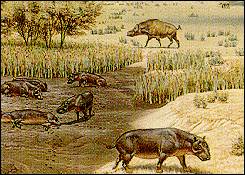 As we stop and look out among the herds of animals dotting the plain, we can see only a few small bands of oreodons. Look! There's a group coming toward us now! Wow! These are some big, ugly ones with large triangularshaped heads. The backs of their cheek bones flare out far to the sides, so that with their narrow snouts they are most peculiar looking. Their bodies are long and rather nondescript, and their legs are short but slender. This particular kind is known as Promerycochoerus ("before ruminant hog") and is just about the largest of the oreodons. They are really a rare sight here at our river. Perhaps the large herds of Menoceras fill their ecologic niche locally, and the oreodons have found they cannot successfully compete with the rhinos for food, water, and living space. After all, not everything can fit into Paradise.
As we stop and look out among the herds of animals dotting the plain, we can see only a few small bands of oreodons. Look! There's a group coming toward us now! Wow! These are some big, ugly ones with large triangularshaped heads. The backs of their cheek bones flare out far to the sides, so that with their narrow snouts they are most peculiar looking. Their bodies are long and rather nondescript, and their legs are short but slender. This particular kind is known as Promerycochoerus ("before ruminant hog") and is just about the largest of the oreodons. They are really a rare sight here at our river. Perhaps the large herds of Menoceras fill their ecologic niche locally, and the oreodons have found they cannot successfully compete with the rhinos for food, water, and living space. After all, not everything can fit into Paradise.
Now take a look to the northeast: there's a herd of Miohippus ("Miocene horse") wading into the river to drink and browse in the willows along its banks. Now, let's be very quiet and take a walk toward the herd slowly. We should take an especially good look at this herd — they are part of a doomed race! The genus Miohippus is making its last stand at this time, soon yielding its place to descendants which can eat grass as a steady diet. Grass is much harsher on the teeth than the foliage that Miohippus eats. In eating grass, grazing animals pick up sand and silt enough to quickly wear away teeth designed for leaf-eating. Much of the environmental pressure coming to bear on the genus Miohippus was a result of mountain building to the west. As the young Rockies rose, rain-bearing winds from the oceans far to the west were wrung of their moisture. This same circumstance makes the high plains a land of little rain today. The scattered trees and groves we see from our vantage point of long ago will disappear and be replaced with a sea of drought-tolerant grasses. In effect, the savannas will give way to prairies. When conditions change, well adapted species may restrict their ranges to what is left of the old environment; they may adapt, if they are able, to the new conditions; or they may not survive if they cannot adapt. Miohippus did all these things. Some species of the genus became extinct. Some evolved into something else. But the end result was the complete termination of the genus Miohippus as paleontologists recognize it. The descendants of Miohippus will become better runners, too, with longer and more powerful legs. As the trees disappear there will no longer be friendly clumps of greenery to hide behind when hungry meat-eaters are on the prowl. From now on, fleetness of foot will be a most important factor in horse survival.
Miohippus will also give rise to somewhat larger forest horses that will survive on into the Pliocene in patches of woodland. They will be little changed except in size (some came to be nearly as large as the modern horse), and some of them will even cross the Bering Land Bridge into Eurasia. This is the last time, however, that we'll see these primitive horses in large numbers here in North America.
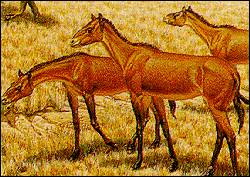 Shhhhh! There's another herd of small horses moving across the plain toward the river from the south! These are feeding as they move across the savanna, eating both leaves from the scattered trees and grass from the prairie. They seem to be enjoying their mixed diet and thriving on it, so they won't be too badly hurt in the geologically near future when they have to eat mostly grass. This is Parahippus ("near horse"), a new kind of horse just recently evolved from Miohippus. Parahippus is a horse of destiny. For a long time some individuals of Miohippus carried a little extra wrinkle of enamel on the crowns of their upper grinding teeth — and now the wrinkle occurs in all individuals of Parahippus. Because of it, Parahippus can eat grass without wearing out its teeth before reaching breeding age, making it possible for most individuals to reproduce before dying. The little wrinkle is passed on. It's only a small advantage, but such is the stuff that survival and evolution are made of. Parahippus is the forerunner of a vast array of different three-toed, long-limbed prairie horses that will be the most numerous members of their family until nearly the end of the Pliocene. From one of their descendants will come the first one-toed horse — the direct ancestor of our modern horses.
Shhhhh! There's another herd of small horses moving across the plain toward the river from the south! These are feeding as they move across the savanna, eating both leaves from the scattered trees and grass from the prairie. They seem to be enjoying their mixed diet and thriving on it, so they won't be too badly hurt in the geologically near future when they have to eat mostly grass. This is Parahippus ("near horse"), a new kind of horse just recently evolved from Miohippus. Parahippus is a horse of destiny. For a long time some individuals of Miohippus carried a little extra wrinkle of enamel on the crowns of their upper grinding teeth — and now the wrinkle occurs in all individuals of Parahippus. Because of it, Parahippus can eat grass without wearing out its teeth before reaching breeding age, making it possible for most individuals to reproduce before dying. The little wrinkle is passed on. It's only a small advantage, but such is the stuff that survival and evolution are made of. Parahippus is the forerunner of a vast array of different three-toed, long-limbed prairie horses that will be the most numerous members of their family until nearly the end of the Pliocene. From one of their descendants will come the first one-toed horse — the direct ancestor of our modern horses.
Look now! More herds are moving in on the river as the morning grows. There's a group of something very small moving through the tall grass, but it's completely hidden. Only the swaying of the 60-centimeter-tall blades shows that a number of animals are hurrying toward the river. Now they've moved out into an area of cropped grass, and we can see a herd of the diminutive deerlike Nanotragulus ("dwarf goat"). Not a great deal larger than a house cat, these little "deer" have tall grinding teeth well adapted for grass-eating. Their ancestry goes back for millions of years into the early Oligocene, when some of their ancestors stood less than 15 centimeters (6 inches) high at the shoulder. But their entire family is soon to become extinct. They are part of the grazing community, although they eat leaves and softer vegetation just as readily. We call them "deer" because they look like miniature deer, but the two families are really only distantly related. As this group scampers toward the river, we can see that they have a peculiar crouching gait — their forelegs are so much shorter than their hind legs that they seem to be running continuously downhill. They are dainty little animals with small, delicate heads and short, slender limbs. They can bound swiftly away if danger threatens, but they'd rather hide in the thick brush. A few of the females have fawns with them, tiny things less than 10 centimeters (4 inches) tall. Look at them all scatter!
The shadow of a hawk has passed over the group, and in their fright they've dived for some nearby willows. Young Nanotragulus either learn to duck down at the sight of a passing shadow or they don't get a chance to learn at all. This time they all got away, and the hawk will have to look elsewhere for a meal. Buteos or buzzard hawks are common along the Niobrara in the early Miocene, sailing on the warm updrafts on broad, short wings that let them ride the lightest airs. They swoop down on the mice and pocket gophers, young rabbits and beavers, baby "deer" and sometimes careless birds that live on this savanna. All manner of meat-eaters depend on the small animals for food, and the little Nanotragulus are most vulnerable as they move through the canopy of grass.
There doesn't seem to be any other herds moving into view just now; but look over there in that patch of short grass is a bird rarely seen in North America anymore. It's a guan, a ground-living bird related to the grouse and sagehens. It must be far from home this morning; most of its time is spent in the thick brush farther back from the river. A heavy body and long neck and tail make this animal easy to identify.
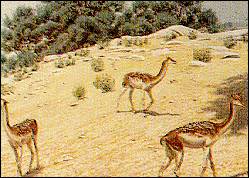 Let's look at some of the individuals and small groups that are moving or resting within view. The camels with the very slender legs and long necks are called Oxydactylus ("sharp finger"). They are browsing on the willows where the herd of Nanotragulus ran to hide. Oxydactylus is an important camel, standing about at the midpoint in the evolution of this North American family of mammals. The camels will remain stay-at-homes in the continent of their origin until they spread into Eurasia and South America at the beginning of the Pleistocene Epoch, some 21.5 million years after the rhinos died out at Agate. There are many species of Oxydactylus; the one we are looking at stands about 1.2 meters (4 feet) high at the shoulder. Notice that
they don't have humps on their backs; in this lush land there is no need to store fat against a time of possible starvation.
Let's look at some of the individuals and small groups that are moving or resting within view. The camels with the very slender legs and long necks are called Oxydactylus ("sharp finger"). They are browsing on the willows where the herd of Nanotragulus ran to hide. Oxydactylus is an important camel, standing about at the midpoint in the evolution of this North American family of mammals. The camels will remain stay-at-homes in the continent of their origin until they spread into Eurasia and South America at the beginning of the Pleistocene Epoch, some 21.5 million years after the rhinos died out at Agate. There are many species of Oxydactylus; the one we are looking at stands about 1.2 meters (4 feet) high at the shoulder. Notice that
they don't have humps on their backs; in this lush land there is no need to store fat against a time of possible starvation.
Speaking of camels, here comes a herd of Stenomylus ("narrow tooth") bounding through the tall grass on the south bank of the river. This is a strange little long-neck camel that strayed off the main line of the family's evolution. Less than 60 centimeters (24 inches) high at the shoulder, it looks very much like the living African antelope called the gerenuk. Stenomylus, with its long and delicate legs and tall cheek-teeth, is perfectly adapted for living in and eating the abundant grass which billows on this treedotted plain. Yet many of the little Stenomylus are going to share a tragic time with hundreds of Menoceras only a year or so from this day we are visiting.
When you travel back 21 million years in time you would expect to find unbelievably strange animals, however, thus far, we've seen some strange animals, but nothing really that could be called bizarre. But now, if you look to the north by the lone oak tree, you will see a real prize. Do you see that hulk stepping out of the shade? At first glance, you might think it's the Dragon of the Ishtar Gate. What a wonderful animal! A head like a large horse, a neck somewhat slimmer, long front legs, sloping back, short hind legs, and a little switch tail. Take out your field glasses and watch when it moves out onto the bare ground. See the feet? Oh my!! They don't have hooves; each toe ends in a great curved claw! This is one of the fabulous chalicotheres, a relative of the horses and the rhinos. There were never very many of them living at one time, but the family lived in Eurasia from the Eocene, some 55 million years ago, through the Pleistocene; and here in North America from the late Eocene to the middle Miocene.
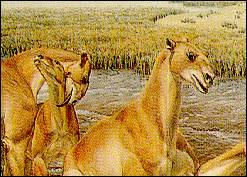 This chalicothere is named Moropus ("sloth foot"), and it is little wonder that when paleontologists first discovered his foot bones (without an associated skull) they thought they had found the feet of a ground sloth. Let's watch Moropus as it ambles slowly across the plain, its strange stilted walk a little like that of the modern giraffe. Other animals move aside as Moropus strides through the grass. He's a browser, an occasional grass-eater, and even a digger of easily accessible roots and tubers. However, like his cousins the rhinos, he isn't at all bright, and he has a very, very short temper. When he's annoyed, he kicks out with those claws and every animal with good sense leaves him alone. He's respected by meat-eaters and plant-eaters alike. He walks by himself and everything else detours around him.
This chalicothere is named Moropus ("sloth foot"), and it is little wonder that when paleontologists first discovered his foot bones (without an associated skull) they thought they had found the feet of a ground sloth. Let's watch Moropus as it ambles slowly across the plain, its strange stilted walk a little like that of the modern giraffe. Other animals move aside as Moropus strides through the grass. He's a browser, an occasional grass-eater, and even a digger of easily accessible roots and tubers. However, like his cousins the rhinos, he isn't at all bright, and he has a very, very short temper. When he's annoyed, he kicks out with those claws and every animal with good sense leaves him alone. He's respected by meat-eaters and plant-eaters alike. He walks by himself and everything else detours around him.
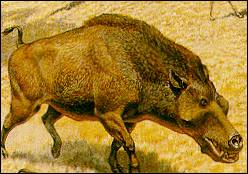 Look down toward the river now and maybe there is one animal who doesn't avoid potential trouble. That two-meter (six-foot) high "pig" walking away from the river, covered with mud, is heading right toward the Moropus. His name is Dinohyus ("terrible pig"), and he's just as short-tempered and stupid as the Moropus. He looks like a giant peccary, but his size and over-large head give him away as an entelodont ("complete tooth"). These are pig-like animals, usually of large size, that aren't related to the domestic pigs at all. Dinohyus' skull is nearly one meter (three feet) long, and those tusks are as thick as a man's wrist. Though we missed seeing him earlier, he must have been wallowing in the mud under the overhanging willows. Now he's heading away from the river in search of lunch. Not very choosy about what he eats; it might be succulent leaves or fruits, or even the carcass of a dead animal, the Dinohyus is an omnivore, eating almost anything that has nourishment. Right now it looks as though he's on a collision course with the Moropus. He's seen the larger animal, has stopped in his tracks, and is pawing the ground with his front feet. Up goes his head — and listen to that roar! He's getting a good temper worked up. Off he goes at a full gallop, right toward the Moropus. WOW! It's hard to believe that an animal as big as that pig could charge so fast! Take a look at the Moropus! He's finally realized in his dim way that he's about to be attacked. Up he goes on his hind legs, holding his front legs out ready for a downward blow with all eight claws, but suddenly Dinohyus shifts his course just slightly, lets out another loud bellow as he avoids the Moropus, and thunders off toward the open prairie.
Look down toward the river now and maybe there is one animal who doesn't avoid potential trouble. That two-meter (six-foot) high "pig" walking away from the river, covered with mud, is heading right toward the Moropus. His name is Dinohyus ("terrible pig"), and he's just as short-tempered and stupid as the Moropus. He looks like a giant peccary, but his size and over-large head give him away as an entelodont ("complete tooth"). These are pig-like animals, usually of large size, that aren't related to the domestic pigs at all. Dinohyus' skull is nearly one meter (three feet) long, and those tusks are as thick as a man's wrist. Though we missed seeing him earlier, he must have been wallowing in the mud under the overhanging willows. Now he's heading away from the river in search of lunch. Not very choosy about what he eats; it might be succulent leaves or fruits, or even the carcass of a dead animal, the Dinohyus is an omnivore, eating almost anything that has nourishment. Right now it looks as though he's on a collision course with the Moropus. He's seen the larger animal, has stopped in his tracks, and is pawing the ground with his front feet. Up goes his head — and listen to that roar! He's getting a good temper worked up. Off he goes at a full gallop, right toward the Moropus. WOW! It's hard to believe that an animal as big as that pig could charge so fast! Take a look at the Moropus! He's finally realized in his dim way that he's about to be attacked. Up he goes on his hind legs, holding his front legs out ready for a downward blow with all eight claws, but suddenly Dinohyus shifts his course just slightly, lets out another loud bellow as he avoids the Moropus, and thunders off toward the open prairie.
Dinohyus has a smaller relative around here somewhere, a little fellow just over one meter (three feet) high, called Entelodon. His head is long and low and has flaring cheekbones and bumps along the underside of the jaw like his larger cousin's. Another pig that lives along the Niobrara is Desmathyus ("bond pig"), a true North American pig or peccary. Its appearance probably wouldn't surprise anyone; it looks very much like the peccaries that live in the American Southwest today. Its distant cousin, the domestic pig, was domesticated in the Old World from a European species of wild hog, and it was spread throughout the world by European colonists. In America, peccary evolution has run a long and conservative path. This group has changed relatively little in the 35 million years since it first appeared in the Oligocene.
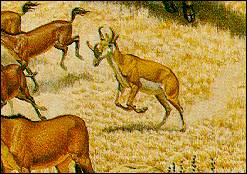 Now for another bizarre and wonderful beast! Trotting daintily out of a thicket on our left is a herd of something you might think were deer or pronghorn. But if you look closely you'll see that they have two pairs of curving, unbranched horns on their heads, not the single pair of prongs you'd expect on a pronghorn. These are Syndyoceras ("together horn"), members of a family of mammals found only in North America and now extinct. Even on the early Miocene day we're visiting, they are scarce, moving only in small herds. The rear pair of horns is not remarkable, but the front ones, which rise from a large bump near the nose, curl up and away from each other, ending in blunt tips. The first member of this family was Protoceras, which lived in the hills and mountains of western South Dakota during the late Oligocene, just a few million years before the day we are visiting at Agate. Paleontologists have found battered scraps of its skeletons in the White River Badlands where perhaps they were washed by heavy spring rains running off the hills to the west. Protoceras had six bony bumps on its head that presumably bore short horns; one pair was over the nose, another was over the eyes, and a third was near the back of the skull. Probably it was the direct ancestor of Syndyoceras.
Now for another bizarre and wonderful beast! Trotting daintily out of a thicket on our left is a herd of something you might think were deer or pronghorn. But if you look closely you'll see that they have two pairs of curving, unbranched horns on their heads, not the single pair of prongs you'd expect on a pronghorn. These are Syndyoceras ("together horn"), members of a family of mammals found only in North America and now extinct. Even on the early Miocene day we're visiting, they are scarce, moving only in small herds. The rear pair of horns is not remarkable, but the front ones, which rise from a large bump near the nose, curl up and away from each other, ending in blunt tips. The first member of this family was Protoceras, which lived in the hills and mountains of western South Dakota during the late Oligocene, just a few million years before the day we are visiting at Agate. Paleontologists have found battered scraps of its skeletons in the White River Badlands where perhaps they were washed by heavy spring rains running off the hills to the west. Protoceras had six bony bumps on its head that presumably bore short horns; one pair was over the nose, another was over the eyes, and a third was near the back of the skull. Probably it was the direct ancestor of Syndyoceras.
If Syndyoceras fails somehow to qualify as grotesque, let's jump a few million years into the future and look at his early Pliocene descendant, Synthetoceras ("combined horn"). Here was an animal on a par with unicorns and cyclopses. Like Syndyoceras he had two tall horns at the back of his head; but something had happened to the curved ones on his nose. They had, during several million years of evolution, grown together into a single shaft and then spread out again to the sides and up.
You may be wondering by now about the smaller animals — the rodents and small carnivores. They're presence has not been noted so far. Most carnivores are out working at night, but there should be a few about. Down by the river is a pair of Oligobunis ("little cusp") hunting near the water's edge. They look something like modern badgers but are really more closely related to the weasels. If you look just to the right of the herd of Stenomylus we were following earlier you might be able to catch a glimpse of a stalking cat about the size of a mountain lion. It's probably either an advanced Nimravus ("ancestral hunter") or an early Pseudaelurus ("false cat"), but we'll need to get a closer look before we can be sure. Whichever it is, it's on the main line of cat evolution and will eventually end up in our familiar Felis and the other modern cats. There should also be some sabretooth cats lurking about; they are found in nearby deposits of the same age, though not at Agate itself.
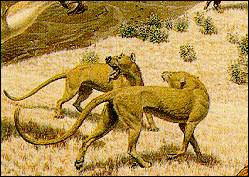 If you look very closely at the thicket just south of us on the hillside you can see several fox-like dogs hunting rodents. This Nothocyon ("false dog") seems to have filled approximately the fox niche during the early Miocene. Some coyote and wolfsized dogs are in the area too. Daphaenodon ("blood-reeking tooth") is about coyote size. Temnocyon ("cutting [tooth] dog"), is a little larger, probably substituted for the wolf in the local fauna, and is characterized by its heavy head and long, strong jaws. If we could get a close look at its teeth, we would see that they are like those of the Cape Hunting Dog living today in South Africa.
If you look very closely at the thicket just south of us on the hillside you can see several fox-like dogs hunting rodents. This Nothocyon ("false dog") seems to have filled approximately the fox niche during the early Miocene. Some coyote and wolfsized dogs are in the area too. Daphaenodon ("blood-reeking tooth") is about coyote size. Temnocyon ("cutting [tooth] dog"), is a little larger, probably substituted for the wolf in the local fauna, and is characterized by its heavy head and long, strong jaws. If we could get a close look at its teeth, we would see that they are like those of the Cape Hunting Dog living today in South Africa.
Now, let's move away from the river about a third of a mile or so and see if we can spot something different. That thicket just ahead might produce a couple of rabbits. Look, there at the edge of the thicket: a Nothocyon has caught something!! It's a Meniscomys ("crescent mouse"), an early relative of the living mountain beaver Aplodontia. Today, a single species of Aplodontia, the last of the line, is found only in the mountains of the West Coast. It's the most primitive living rodent, not related to the Canadian beaver, and sole survivor of a suborder which was the earliest rodent group to evolve. Meniscomys was one of the most prominent members of the group during the Miocene. It had a round furry body, a round head with protruding incisors a bit like a true beaver's, and no visible tail. Oops! Watch your step! Look, there is the mound of a pocket gopher. It is neither our familiar western gopher Thomomys ("heap mouse") or the "eastern" pocket gopher of the Great Plains, Geomys ("earth mouse"), but an ancient relative, Gregorymys ("Gregory's mouse"). It must be pretty successful as a burrowing animal, because we find it all over the western United States in the early Miocene.
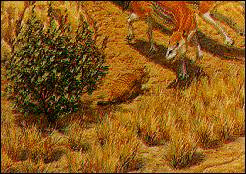 Another three hundred feet more and we'll show you the surprise of the day!! Here we are in what looks like a prairie dog town. But those aren't prairie dogs, as these are larger. These are beavers — Palaeocastor ("ancient beaver") to be exact. Here in the early Miocene of North America, beavers don't build dams. In fact they live neither at the water's edge nor, like muskrats, in the water. They dig deep, spiral burrows in well drained ground. Some of their burrows are 2.5 meters (8 feet) deep, but 2 meters (6.5 feet) is about average. Down and around and around the burrows go, like giant corkscrews, always ending in straight shafts slanting slightly upward so that living chambers will not be flooded by rainwater running down the burrows. Paleontologists have called the preserved burrows "devil's corkscrews" — Daemonelix — since the time they were first found. At first, scientists thought they might be holes left by the giant tap roots of some unknown plant. But when Palaeocastor skeletons were found in the bottoms of the spirals, almost everyone had to concede that they were truly beaver burrows. Admittedly, the skeleton of a Nothocyon was found in one burrow; but this predator probably followed a beaver home for supper and just stayed. Three other kinds of beavers lived around Agate in the early Miocene, but their bones have never been found in the burrows. No one knows what they did for homes: perhaps their burrows were much shallower or were in the river banks where running water soon destroyed them.
Another three hundred feet more and we'll show you the surprise of the day!! Here we are in what looks like a prairie dog town. But those aren't prairie dogs, as these are larger. These are beavers — Palaeocastor ("ancient beaver") to be exact. Here in the early Miocene of North America, beavers don't build dams. In fact they live neither at the water's edge nor, like muskrats, in the water. They dig deep, spiral burrows in well drained ground. Some of their burrows are 2.5 meters (8 feet) deep, but 2 meters (6.5 feet) is about average. Down and around and around the burrows go, like giant corkscrews, always ending in straight shafts slanting slightly upward so that living chambers will not be flooded by rainwater running down the burrows. Paleontologists have called the preserved burrows "devil's corkscrews" — Daemonelix — since the time they were first found. At first, scientists thought they might be holes left by the giant tap roots of some unknown plant. But when Palaeocastor skeletons were found in the bottoms of the spirals, almost everyone had to concede that they were truly beaver burrows. Admittedly, the skeleton of a Nothocyon was found in one burrow; but this predator probably followed a beaver home for supper and just stayed. Three other kinds of beavers lived around Agate in the early Miocene, but their bones have never been found in the burrows. No one knows what they did for homes: perhaps their burrows were much shallower or were in the river banks where running water soon destroyed them.
Near the river bank in some soft sand is a nest of tortoise eggs. The hot sun has brought the babies out of their shells and they're stumbling off in all directions. Right now the biggest is only about twice the size of a silver dollar; but when they're grown they'll be about 60 centimeters (24 inches) across the shell, or perhaps even larger. They're strict vegetarians, grazing and browsing on soft plants and leaves. There are probably some pond turtles around too, but we've never seen any. A little farther up the bank, under the roots of that big walnut tree, is a rabbit's burrow. Several Palaeolagus ("ancient rabbit") live there with their many offspring. Although they look very much like cottontails, their ears are smaller and they haven't the same leaping and running ability. They'd much rather hide than flee their enemies.
These dwellers of the savanna, common during the Miocene epoch, comprise the major species found at the Agate Fossil Beds, their fossils discovered in the early 1900s. This find was highly important to the young science of paleontology.
Editor's Note
So, how do these beasts relate to Gor? Quite likely, John Norman has adapted several beasts of the prehistoric variety in the creation of some of his Gorean beasts. But even moreso, is that technology of the Priest-Kings that has been practice over several millenia.
We learned in Priest-Kings of Gor that the planet of Gor itself was moved to its current location of being the counter-earth over two (2) million years ago. However, the planet Gor was very much alive prior to that time. Necessities of prolonging the Nest of the Priest-Kings and keeping it safe from their enemies, such as the Kur, resulted in the move of the planet. How long had the Priest-Kings been around? They claim eternally. Certainly, they likely were around millenia before the existence of man, perpetrating their zoos and biological experiments, and we could reasonably assume that at least some of the beasts found on Gor are those of our own prehistoric beasts of earth yet not in their pure form. The arrival of man brought them a new animal to experiment on, which they did; the Muls Al-Ka and Ba-Ta are prime examples of the experiment of genetic mutation and manipulations. Another is the ancient mankind of some world perhaps not even of earth, that were raised to be the carriers of the precious Gur.
![]()
Special Note
Because of the differences in publishing the books, depending upon whether published in the U.S. or Europe, depending upon whether a first publishing or a Masquerade Books release, page numbers will often vary. All of my quotes are from original, first-printing U.S. publications (see The Books page for a listing of publishers and dates) with the exception of the following books:
- Tarnsman of Gor (2nd Printing, Balantine)
- Outlaw of Gor (11th Printing, Balantine)
- Priest-Kings of Gor (2nd Printing, Balantine)
- Assassin of Gor (10th Printing, Balantine)
- Raiders of Gor (15th Printing, Balantine)
- Captive of Gor (3rd Printing, Balantine)
Disclaimer
These pages are not written for any specific home, but rather as informational pages for those not able to get ahold of the books and read them yourself. Opinions and commentaries are strictly my own personal views, therefore, if you don't like what you are reading — then don't. The information in these pages is realistic to what is found within the books. Many sites have added information, assuming the existences of certain products and practices, such as willowbark and agrimony for healing, and travel to earth and back for the collection of goods. I've explored the books, the flora, the fauna, and the beasts, and have compiled from those mentioned, the probabilities of certain practices, and what vegetation mentioned in the books is suitable for healing purposes, as well as given practicalities to other sorts of roleplaying assumptions.
